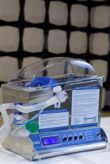PTB investigates indoor air purifier developed in Braunschweig
The Physikalisch-Technische Bundesanstalt (PTB) measured the internal irradiance of a prototype of an indoor UV-C air purification unit to gauge its effectiveness in neutralizing germs and viruses. A simulation of the irradiance distribution in the unit also enabled us to investigate the suitability of the lamp arrangement that was finally selected. After investigating this prototype, it can be estimated that viruses drawn through the unit can be destroyed, and thus, in principle, the viral load in the air in rooms can be significantly reduced.

Dr. Peter Sperfeld performs measurements of UV-C radiation on an open prototype of an indoor air purification unit.
In the fight against corona, there is often a lot of talk about so-called UV-C radiation, which can destroy viruses and germs. This radiation, which can be generated by special lamps, destroys certain parts of the genetic material (DNA/RNA) of viruses and microorganisms and thus prevents them from multiplying. In fact, high-energy short-wave radiation is already being used successfully in many waterworks to purify drinking water. Certified plants often use low-pressure discharge lamps, which are surrounded by water and destroy 99.9999 % of microorganisms and viruses with their antimicrobial effects. The lamps used are similar to “fluorescent tubes” without fluorescent material and emit UV-C radiation at a wavelength of 254 nm, i.e. outside the range visible to humans (hence “ultraviolet”, UV). Low-pressure discharge lamps are also increasingly being used to disinfect indoor air and are another effective way of significantly reducing the viral load in rooms.

Simulated irradiance distribution for eight lamps in the centre of the tube (side view)
Scientists in PTB’s Photometry and Spectroradiometry Department carried out radiometric measurements on a prototype developed by a Braunschweig-based company to provide a low-cost UV-C air purifier for classrooms. In a large tube containing up to eight long UV lamps, a fan guides the air from the room past the low-pressure discharge lamps from bottom to top. Measurements along the tube give an impression of the effective irradiance inside the unit.
DIALux evo lighting design software was used to calculate the radiation distribution inside the unit and compare it with the measurement results. Our scientists found that a highly effective irradiance was present in large areas inside this UV-C air purification unit. In conjunction with the velocity of the air flowing through it, it is possible to estimate the irradiation dose that acts on virus-contaminated aerosols as they pass through the tube. Combined with the air exchange rate within a room, it can be estimated by what proportion the virus load in the room is reduced.

Simulated irradiance distribution along the tube (side view)
However, the highly effective, high-energy UV-C radiation is also very harmful to the skin and eyes. It must therefore be ensured that virtually no UV-C radiation occurs outside the indoor air purifier. To this end, PTB has carried out measurements with highly sensitive measuring instruments and, for a fully equipped and properly installed unit, has not been able to detect any significant UV-C radiation outside the tube. The indoor air purifier is therefore completely safe when operated correctly. It is still necessary to conclusively clarify which radiation dose and circulation rate are exactly required to neutralize almost all SARS-CoV-2 viruses in the air of a room in continuous operation (e.g. during a lesson). Various studies are therefore currently being carried out worldwide. After investigating the prototype, however, our scientists have estimated that viruses passing through the tube will be destroyed, and thus the viral load in the air in a room can, in principle, be significantly reduced.
Contacts
Dr. Peter Sperfeld, Department 4.1 Photometry and Spectroradiometry, phone: +49(531) 592-4144, e-mail: peter.sperfeld@ptb.de
Dr. Johannes Ledig, Department 4.1 Photometry and Spectroradiometry, phone: +49(531) 592-4120, e-mail: johannes.ledig@ptb.de
Images © PTB, 2020
Information regarding the featured image: Simulated irradiance distribution for eight lamps in the centre of the tube (top view, pseudocolour)








